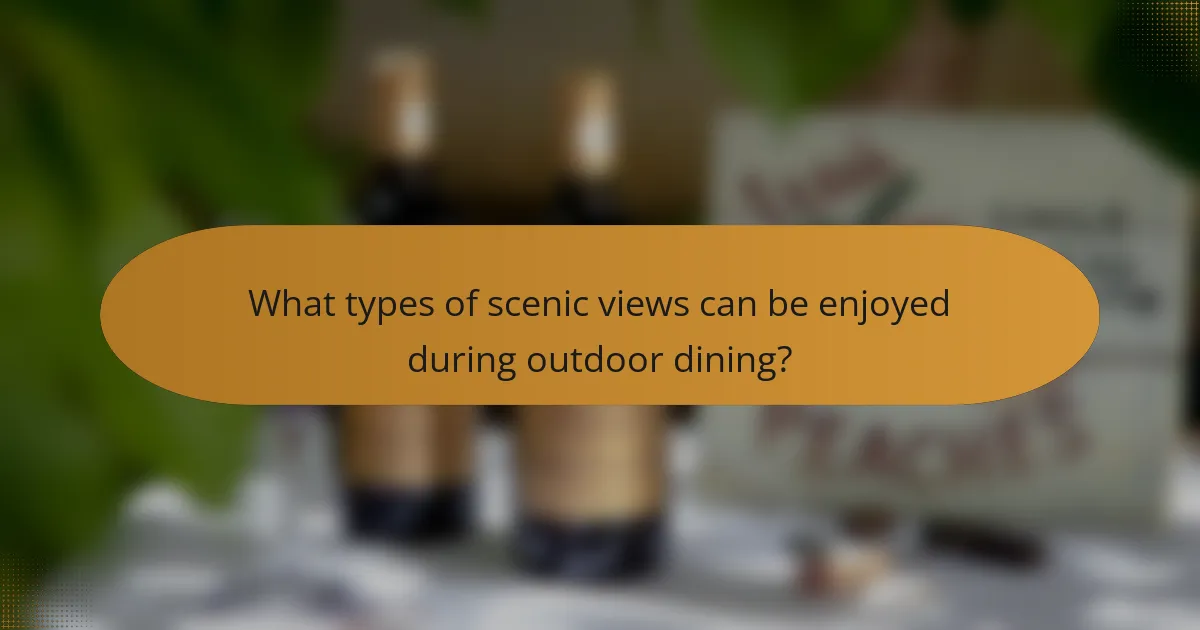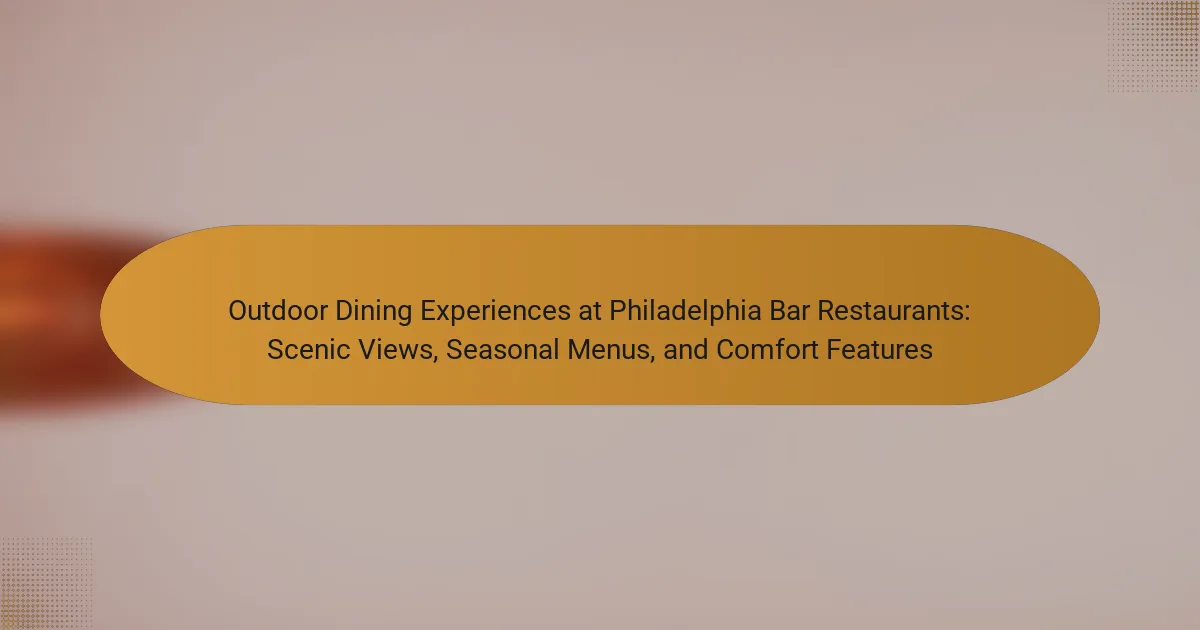
What are Outdoor Dining Experiences at Philadelphia Bar Restaurants?
Outdoor dining experiences at Philadelphia bar restaurants offer unique settings for patrons. These experiences often include scenic views of the city or waterfront. Many establishments feature seasonal menus that highlight fresh, local ingredients. Comfort features like outdoor heaters and umbrellas enhance the dining experience. Popular spots often have vibrant atmospheres, attracting both locals and tourists. The combination of food, ambiance, and views creates a memorable outing. Philadelphia’s outdoor dining scene has grown, especially during warmer months. This trend reflects a broader shift toward al fresco dining in urban areas.
How do outdoor dining experiences enhance the dining atmosphere?
Outdoor dining experiences enhance the dining atmosphere by providing a natural setting that promotes relaxation. The presence of fresh air and natural light creates a more inviting space. This environment encourages social interaction among diners. Research indicates that outdoor settings can reduce stress levels, making meals more enjoyable. Scenic views contribute to the overall dining experience, offering visual stimulation. Seasonal menus often incorporate fresh, local ingredients, enhancing flavor and quality. Comfort features like outdoor heaters or shade structures add to the appeal. Overall, outdoor dining experiences create a unique ambiance that indoor settings may lack.
What role do scenic views play in outdoor dining experiences?
Scenic views enhance outdoor dining experiences by creating a visually appealing atmosphere. They contribute to the overall enjoyment of the meal. Patrons often report that beautiful landscapes improve their dining satisfaction. Research indicates that environments with natural beauty can elevate mood and relaxation. A study published in the Journal of Environmental Psychology found that views of nature can reduce stress and increase happiness. Therefore, scenic views not only attract customers but also positively impact their dining experience.
How does the ambiance contribute to customer satisfaction?
Ambiance significantly contributes to customer satisfaction by creating an inviting atmosphere. A well-designed ambiance enhances the overall dining experience. Factors such as lighting, music, and decor affect patrons’ moods. For instance, soft lighting can promote relaxation, while upbeat music can energize customers. Studies indicate that pleasant surroundings lead to longer visits and increased spending. According to a study by the Cornell University School of Hotel Administration, ambient conditions can influence customers’ perceptions of food quality. Therefore, a positive ambiance is essential for enhancing customer satisfaction in outdoor dining settings.
Why are seasonal menus important for outdoor dining?
Seasonal menus are important for outdoor dining because they enhance the dining experience by utilizing fresh, local ingredients. Fresh ingredients are often at their peak flavor and nutritional value during their respective seasons. This practice supports local farmers and reduces transportation emissions, promoting sustainability. Seasonal menus also allow restaurants to be creative and innovative with their offerings, keeping the menu exciting for returning customers. According to the National Restaurant Association, 70% of consumers are more likely to visit a restaurant that offers seasonal dishes. This indicates a strong consumer preference for seasonal dining experiences. Additionally, seasonal menus can reflect the local culture and traditions, providing a unique experience that connects diners to the region.
What benefits do seasonal menus offer to diners?
Seasonal menus offer diners fresh and high-quality ingredients. These menus utilize produce that is at its peak, enhancing flavor and nutrition. Diners experience a diverse range of dishes that change with the seasons. This variety keeps the dining experience exciting and engaging. Seasonal menus often reflect local culinary traditions and promote regional cuisine. They support local farmers and contribute to the local economy. In addition, seasonal menus can reduce the environmental impact associated with long-distance food transportation. Overall, diners benefit from an enhanced, sustainable, and flavorful dining experience.
How do seasonal ingredients impact the dining experience?
Seasonal ingredients significantly enhance the dining experience by providing freshness and flavor. They reflect the local environment and culinary traditions. Utilizing seasonal produce can lead to dishes that are more vibrant and aromatic. This practice often results in higher nutritional value. Seasonal menus also create a sense of urgency and excitement for diners. Guests may feel more connected to the locality through these ingredients. Furthermore, restaurants can reduce their carbon footprint by sourcing locally. This approach can foster a sustainable dining culture, appealing to environmentally conscious patrons.
What comfort features are essential for outdoor dining?
Essential comfort features for outdoor dining include shade, comfortable seating, and heating options. Shade is crucial for protection from direct sunlight. It can be provided by umbrellas or canopies. Comfortable seating enhances the dining experience. Cushioned chairs or benches are preferred for longer meals. Heating options, like patio heaters, extend the outdoor dining season. These features ensure guests remain comfortable regardless of weather conditions. Research shows that comfortable environments increase customer satisfaction in dining settings.
How do heating and cooling options enhance outdoor dining comfort?
Heating and cooling options significantly enhance outdoor dining comfort by regulating temperature. They provide warmth during colder months and relief in hot weather. Outdoor heaters can increase the ambient temperature by up to 30 degrees Fahrenheit. This allows patrons to enjoy dining experiences comfortably even in chilly conditions. Conversely, misting systems can lower temperatures by several degrees, creating a cool environment. Research shows that comfortable temperatures can increase customer satisfaction and prolong dining duration. This ultimately leads to higher sales for restaurants. Thus, effective heating and cooling options are essential for a pleasant outdoor dining atmosphere.
What seating arrangements are most popular in outdoor settings?
Popular seating arrangements in outdoor settings include picnic tables, lounge chairs, and patio dining sets. Picnic tables offer communal seating and are ideal for larger groups. Lounge chairs provide comfort and relaxation for individual patrons. Patio dining sets typically consist of tables and chairs, allowing for a more formal dining experience. These arrangements facilitate social interaction and enhance the outdoor ambiance. Many restaurants also utilize flexible seating options, such as benches or bar stools, to accommodate varying group sizes. The choice of arrangement often depends on the restaurant’s theme and target audience.
How do outdoor dining experiences in Philadelphia differ from other cities?
Outdoor dining experiences in Philadelphia are characterized by unique historical and cultural elements that set them apart from other cities. Philadelphia’s outdoor dining often features historic settings, such as patios overlooking landmarks like the Liberty Bell. Seasonal menus are prevalent, showcasing local ingredients and traditional dishes, which reflect the city’s culinary heritage. The city’s outdoor spaces are designed to enhance comfort, with features like heat lamps and canopies to accommodate varying weather conditions. Additionally, Philadelphia’s vibrant street life contributes to a lively atmosphere, attracting both locals and tourists. This combination of historical context, seasonal offerings, and comfort-oriented design creates a distinctive outdoor dining experience that is not commonly found in other urban areas.
What are the unique aspects of Philadelphia bar restaurants’ outdoor dining?
Philadelphia bar restaurants’ outdoor dining features distinctive elements. These include scenic views of iconic city landmarks. Many establishments utilize street-side patios for an immersive urban experience. Seasonal menus highlight local ingredients and craft beverages. Outdoor dining spaces often incorporate unique decor and ambiance. Heat lamps and canopies enhance comfort during cooler months. Some venues host live music events to attract patrons. The vibrant atmosphere encourages social interaction among diners.

What types of scenic views can be enjoyed during outdoor dining?
Outdoor dining can offer various scenic views. Patrons may enjoy waterfront vistas, such as rivers or lakes. City skylines provide a dynamic backdrop, especially during sunset. Natural landscapes, including parks and gardens, enhance the dining experience. Mountain views can also be a striking feature in some locations. Additionally, urban street scenes can create a vibrant atmosphere. Scenic views contribute to the overall enjoyment of outdoor dining. Studies show that beautiful surroundings can enhance customer satisfaction and dining duration.
How do waterfront views enhance the dining experience?
Waterfront views significantly enhance the dining experience by providing a visually appealing backdrop. The serene water setting creates a calming ambiance. This atmosphere positively influences diners’ mood and enjoyment. Studies show that pleasant views can increase meal satisfaction. A waterfront location often attracts more customers due to its scenic appeal. Customers are likely to spend more time and money in visually stimulating environments. Therefore, waterfront views contribute to a memorable dining experience.
What are the most popular waterfront dining locations in Philadelphia?
The most popular waterfront dining locations in Philadelphia include The Deck at Franklin Square, Morgan’s Pier, and The Water Works. The Deck at Franklin Square offers a casual atmosphere with views of the square’s fountain. Morgan’s Pier is known for its vibrant beer garden and seasonal menu. The Water Works features upscale dining with a historic setting overlooking the Schuylkill River. Each location provides unique views and a distinct dining experience along Philadelphia’s waterfront.
How do cityscape views compare to nature views in outdoor dining?
Cityscape views in outdoor dining offer a vibrant urban atmosphere, while nature views provide tranquility and natural beauty. Urban settings often feature lively street scenes, architectural landmarks, and a bustling environment. This dynamic backdrop can enhance the dining experience through energy and excitement. In contrast, nature views typically include greenery, water features, and open spaces, promoting relaxation and a sense of escape. Studies show that dining in natural settings can reduce stress and enhance well-being. For instance, research published in “Environmental Science & Technology” by Kaplan and Kaplan indicates that exposure to nature improves mood and cognitive function. Therefore, the choice between cityscape and nature views in outdoor dining ultimately depends on the desired ambiance and experience.
What seasonal menu highlights can diners expect throughout the year?
Diners can expect seasonal menu highlights that change throughout the year. In spring, fresh salads and light seafood dishes often feature prominently. Summer menus typically include grilled meats and vibrant vegetable dishes. Fall brings hearty soups and pumpkin-flavored items to the forefront. Winter menus frequently showcase comforting casseroles and rich, warming entrees. Each season emphasizes local and seasonal ingredients, enhancing the dining experience. Philadelphia bar restaurants often adapt their offerings to reflect these seasonal changes. This approach not only highlights freshness but also supports local agriculture.
What ingredients are typically featured in spring and summer menus?
Spring and summer menus typically feature fresh, seasonal ingredients. Common ingredients include asparagus, peas, and radishes. These vegetables are known for their vibrant flavors and crisp textures. Fruits like strawberries, cherries, and peaches are also popular during these seasons. They add sweetness and brightness to dishes. Herbs such as basil, mint, and cilantro enhance flavors and provide freshness. Additionally, seafood options like shrimp and fish are often highlighted, as they are light and complement warm weather dining. Grains like quinoa and farro may be included for nutritious bases in salads and bowls. Overall, the focus is on fresh, flavorful, and light ingredients that celebrate the season.
How do fall and winter menus differ in terms of offerings?
Fall and winter menus differ primarily in their ingredient selections and preparation styles. Fall menus often feature seasonal produce like pumpkins, squash, and apples. These ingredients are commonly used in soups, salads, and hearty dishes. In contrast, winter menus tend to emphasize warming ingredients such as root vegetables, winter greens, and proteins. Dishes often include stews, roasts, and comforting casseroles.
Additionally, fall menus may include lighter fare and fresh herbs, while winter menus focus on rich, savory flavors. The shift in offerings aligns with the colder weather, as diners seek warmth and comfort in their meals. This seasonal adjustment is common across many restaurants, reflecting local agricultural availability and culinary trends.
What comfort features should diners look for when choosing an outdoor restaurant?
Diners should look for several comfort features when choosing an outdoor restaurant. Comfortable seating is essential, as it enhances the dining experience. Umbrellas or awnings provide shade and protection from the elements. Heating lamps are beneficial for cooler evenings. Adequate spacing between tables ensures privacy and comfort. Access to restrooms is also important for convenience. Ambient lighting creates a pleasant atmosphere during the evening. Finally, noise levels should be manageable to facilitate conversation. These features contribute to a more enjoyable outdoor dining experience.
How can restaurants provide adequate shelter from the elements?
Restaurants can provide adequate shelter from the elements by installing awnings, umbrellas, and outdoor heaters. Awnings can block rain and sun, creating a comfortable dining area. Umbrellas offer portable shade and rain protection for individual tables. Outdoor heaters extend the dining season by keeping patrons warm during cooler months. Enclosed patios or tents can protect against wind and rain while allowing for ventilation. These solutions enhance the outdoor dining experience by ensuring comfort regardless of weather conditions. Research shows that well-designed outdoor spaces can increase customer satisfaction and retention.
What amenities enhance the overall outdoor dining experience?
Amenities that enhance the overall outdoor dining experience include comfortable seating, shade structures, and ambient lighting. Comfortable seating promotes relaxation and enjoyment during meals. Shade structures protect diners from harsh sunlight and rain. Ambient lighting creates a warm and inviting atmosphere for evening dining. Additionally, heating elements, such as patio heaters, extend the dining season into cooler months. Access to outdoor restrooms improves convenience for guests. High-quality tableware and utensils elevate the dining experience. Finally, well-maintained greenery and decor contribute to an aesthetically pleasing environment. These amenities collectively improve customer satisfaction and encourage repeat visits.

How can diners maximize their outdoor dining experiences in Philadelphia?
Diners can maximize their outdoor dining experiences in Philadelphia by choosing restaurants with scenic views. Many establishments offer patios that overlook the city skyline or waterfront. Selecting a time for dining during sunset enhances the visual experience. Additionally, diners should check seasonal menus that feature local ingredients, which often provide fresh and unique flavors. Reservations are advisable, especially during peak seasons, to secure a preferred outdoor table. Comfort features like heaters or umbrellas can enhance enjoyment during varying weather conditions. Engaging with staff about daily specials can lead to discovering hidden gems on the menu. Exploring diverse neighborhoods can also introduce diners to various culinary styles and atmospheres.
What tips can enhance enjoyment during outdoor dining?
To enhance enjoyment during outdoor dining, choose a comfortable setting with ample shade. Selecting a table with a scenic view can significantly improve the experience. Ensure the weather is pleasant, avoiding extreme temperatures or rain. Bringing along a light blanket can add comfort during cooler evenings. Opt for seasonal menus that feature fresh ingredients, as they often provide better flavor. Pairing meals with refreshing beverages enhances taste and satisfaction. Engage in conversation with companions to create a lively atmosphere. Finally, consider the timing of your meal; dining during sunset can offer a visually stunning experience.
How to choose the best time for outdoor dining to avoid crowds?
To choose the best time for outdoor dining to avoid crowds, consider dining during off-peak hours. Typically, weekdays are less crowded than weekends. Lunch hours before noon and dinner hours after 8 PM often have fewer diners. Additionally, dining during the shoulder seasons, like early spring or late fall, can also reduce crowd sizes. Observing local dining trends can provide insights into busy times. For instance, popular restaurants may experience peak crowds around major events or holidays.
What should diners consider when selecting a restaurant for outdoor seating?
Diners should consider several factors when selecting a restaurant for outdoor seating. First, the ambiance is crucial. A pleasant environment enhances the dining experience. Second, the availability of shade or cover is important. This protects diners from sun or rain. Third, the seating arrangement should be comfortable. Comfortable seating encourages longer visits and enjoyment. Fourth, the menu offerings should cater to outdoor dining. Seasonal and fresh options are often preferred in outdoor settings. Fifth, proximity to noise sources should be evaluated. A quieter location contributes to a more enjoyable meal. Lastly, health and safety measures should be in place. Cleanliness and proper spacing are vital for a safe dining experience.
Outdoor dining experiences at Philadelphia bar restaurants encompass unique settings that feature scenic views, seasonal menus, and essential comfort attributes. These experiences enhance the dining atmosphere by promoting relaxation and social interaction, with natural light and fresh air contributing to overall enjoyment. Seasonal menus highlight fresh, local ingredients, while comfort features such as heating and shade ensure a pleasant experience regardless of weather conditions. The article will explore how these elements combine to create memorable outdoor dining experiences that reflect Philadelphia’s vibrant culinary culture and urban environment.




